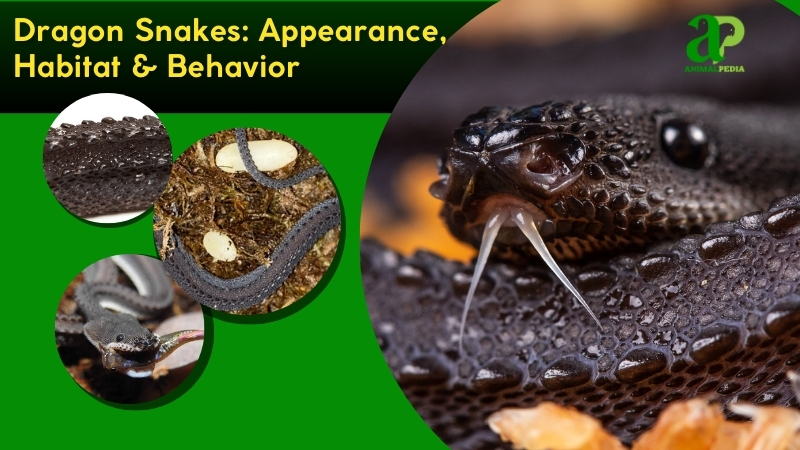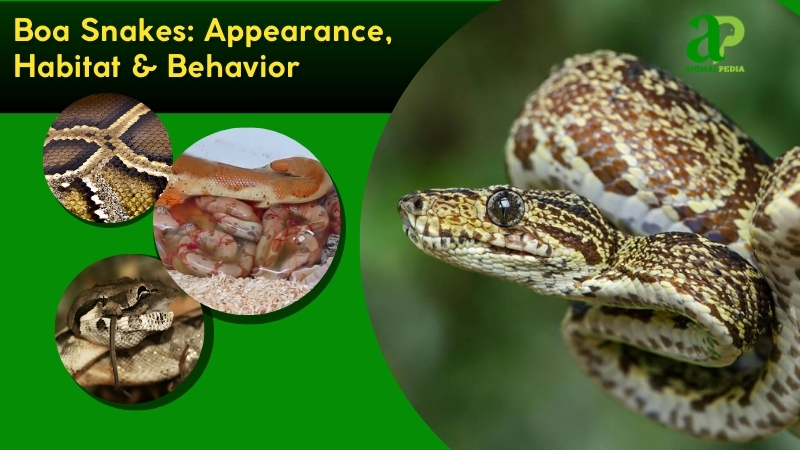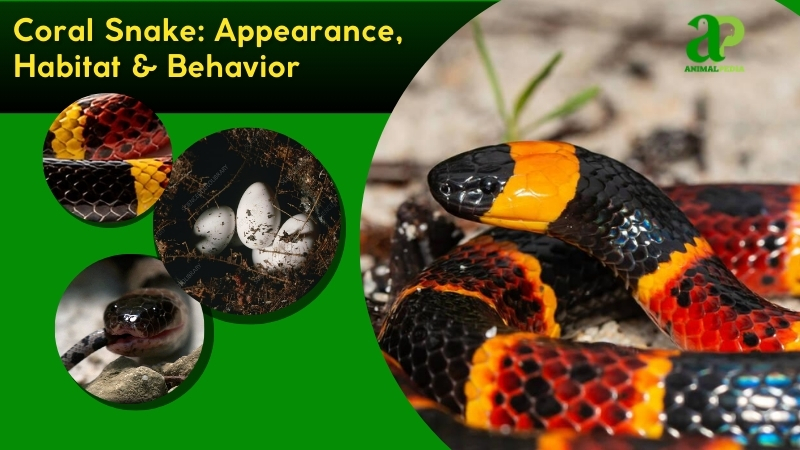King snakes belong to the genus Lampropeltis, with about 14 species. These non-venomous constrictors showcase vibrant patterns of black, white, red, or yellow bands. Key species include the common king snake (L. getula), milk snake (L. triangulum), and scarlet king snake (L. elapsoides). Their bold coloration mimics venomous coral snakes—a clever survival tactic.
Found across North and Central America, from southern Canada to northern South America, these reptilian predators thrive in forests, deserts, and grasslands. Some populations inhabit specific regions like Isla Cerralvo in Mexico. Most king snakes measure 3-6 feet, with exceptional specimens reaching 7 feet.
Their hunting prowess defines them. Though not apex predators, they dominate smaller reptiles, including other snakes—earning their royal name. King snakes hunt by constriction, targeting rodents, birds, amphibians, and reptiles. They can even prey on venomous species like rattlesnakes, thanks to their immunity to certain venoms.This immunity is so profound that they are well-known predators of formidable pit vipers, including the Eastern Diamondback Rattlesnake. Their diets vary by region, showing ecological adaptability.
Human interactions minimal, king snakes display docile behavior, making them popular pets due to their manageable size and temperament.
Reproduction occurs yearly, with mating in spring. Females lay 3-24 eggs in summer, often in moist, hidden locations like rotting logs. After 50-60 days of incubation, hatchlings emerge at 8-12 inches. Juveniles hunt independently from birth. They reach maturity in 2-4 years, with lifespans of 15-20 years wild, longer in captivity.
The ecological significance of king snakes is substantial. They control pest populations and influence local ecosystems by preying on other snakes. Their adaptability ensures survival across diverse climates.
This article explores king snakes’ appearance, habitat, and behavior, highlighting their ecological and biological importance.
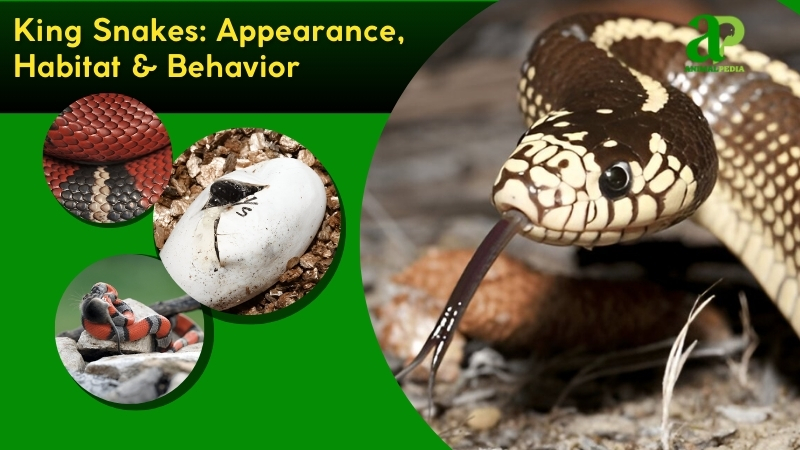
What Do The King Snakes Look Like?
King snakes have sleek, cylindrical bodies with vibrant coloration. They display bands or speckles of black, white, red, yellow, or orange—a form of Batesian mimicry that resembles venomous coral snakes. The common king snake (Lampropeltis getula) features bold bands, while the milk snake (Lampropeltis triangulum) shows distinct saddle-like patterns. Their smooth, glossy scales feel slick to the touch and help them move efficiently through various habitats, including forests and deserts.
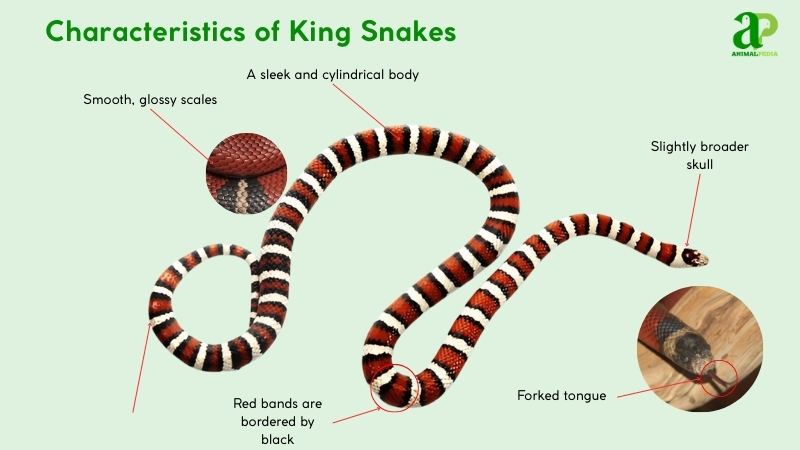
The head of a king snake is slightly broader than its neck, with small, dark eyes that excel at detecting prey movement. Their forked tongue constantly flicks to collect environmental scents. The muscular body tapers to a narrow tail. A critical identification feature: unlike coral snakes, where red and yellow bands touch (“red touches yellow, kills a fellow”), king snakes’ red bands are bordered by black bands.
Compared to rat snakes (Pantherophis species), king snakes are shorter, stockier, and display more vivid patterns. Rat snakes possess keeled scales that feel rough, while king snakes maintain their characteristic glossy finish. These distinctive traits—color pattern separation and scale texture—help identify these constrictors throughout their North and Central American range.
To grasp the overall picture, see the classification of snakes.
How Big Do King Snakes Get?
King snakes typically measure 3-6 feet (0.9-1.8 meters) in length and weigh 0.5-2 pounds (0.2-0.9 kg). These non-venomous constrictors vary by species, with the common king snake (Lampropeltis getula) often reaching the upper end. Adult king snakes have a snout-to-tail length averaging 4 feet (1.2 meters), with slender, muscular bodies adapted for agility. Their size supports their role as versatile predators in diverse habitats across North and Central America.
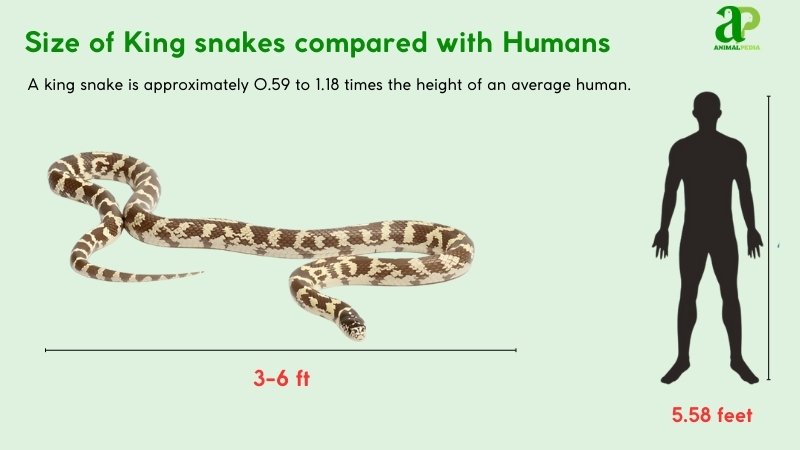
The largest recorded king snake, a California king snake (Lampropeltis californiae), stretched 7 feet (2.1 meters) and weighed 3 pounds (1.4 kg), found in Arizona. Males are slightly longer and heavier than females, with males averaging 4.5 feet (1.4 meters) and females 4 feet (1.2 meters). Below is a comparison:
| Trait | Male | Female |
| Length | 4-5 ft (1.2-1.5 m) | 3.5-4 ft (1-1.2 m) |
| Weight | 1-2 lbs (0.5-0.9 kg) | 0.5-1.5 lbs (0.2-0.7 kg) |
What Are The Unique Physical Characteristics Of King Snakes?
King snakes display striking banded patterns that mimic venomous coral snakes—a survival strategy called Batesian mimicry. Their alternating bands of red, black, and yellow or white create a distinctive appearance unlike other non-venomous serpents.
Unlike rat snakes, king snakes have sharply defined bands where red never touches yellow or white, always separated by black. Their smooth, glossy scales create a sleek texture that stands apart from the rough-scaled relatives in the colubrid family.
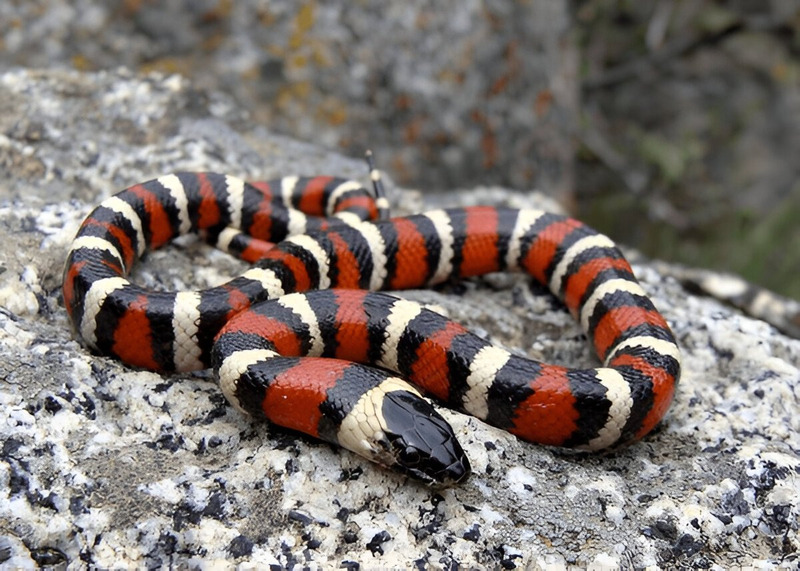
Genetic research from 2019 by Cogger & Zweifel revealed that specialized pigmentation genes control the vivid banding in Lampropeltis species. These genetic markers differ from those producing the blotched or uniform patterns seen in related colubrids. The genes maintain consistent band width and color intensity across various subspecies, including the milk snake (Lampropeltis triangulum).
Ernst’s 2017 studies showed that king snake scale microstructure uniquely reflects light to enhance color brilliance—a characteristic exclusive to this genus. This combination of mimicry and specialized scale structure makes king snakes visually distinctive in their habitat.
How Do King Snakes Survive With Their Unique Features?
King snakes survive through Batesian mimicry—bright bands that copy venomous coral snakes—keeping predators away across North and Central America. Their striking red, black, and yellow/white patterns fool threats, reducing attacks. Glossy scales help them glide through deserts and forests, making escape and hunting easier. Research from 2019 confirms this mimicry has genetic roots, proving its survival value.
Their sensory adaptations strengthen survival skills. Sharp vision spots prey movement for better hunting. Their forked tongues collect chemical signals, helping them find food in complex habitats. Vibration detection through their scales warns of approaching dangers, allowing quick escapes. Powerful muscles enable constriction, helping them secure prey across diverse ecosystems.
Anatomy
King snakes thrive through 5 key anatomical systems that power their predatory success.
- Respiratory System: King snakes rely on a single dominant right lung. Air enters through the glottis, enabling efficient oxygen absorption. This system lets them breathe while constricting prey, critical for hunting across diverse landscapes.
- Circulatory System: Their three-chambered heart circulates blood throughout the body. Though mixing oxygenated and deoxygenated blood occurs, robust vessels support intense hunting activities. Recent herpetological studies confirm this system sustains their energy needs across various habitats.
- Digestive System: A streamlined digestive tract processes whole prey. Powerful gastric acids dissolve bones and tissue completely. This adaptation enables king snakes to consume a diverse range of prey, from mammals to other reptiles, supporting their role as generalist predators.
- Excretory System: Efficient kidneys filter waste, producing uric acid rather than urine. This water-conservation mechanism is essential in arid environments, explaining their success in desert regions while minimizing dehydration risk.
- Nervous System: Well-developed neural structures coordinate hunting behaviors and defensive mimicry. Specialized receptors detect subtle vibrations and chemical signals. These sensory adaptations drive their hunting efficiency.
Together, these anatomical systems enable king snakes to function as adaptable predators that maintain ecological balance across their range despite challenges in prey availability and habitat diversity.
How Many Types Of King Snakes?
King snakes, genus Lampropeltis, comprise about 14 distinct species. Notable types include the common king snake (Lampropeltis getula), milk snake (Lampropeltis triangulum), and scarlet king snake (Lampropeltis elapsoides). These non-venomous constrictors inhabit North and Central America, showcasing diverse patterns and adaptations.
Classification relies on morphological and genetic traits, formalized by herpetologist Albert Günther in the 19th century, with modern refinements via DNA analysis. The taxonomic foundation integrates physical characteristics like scale patterns and molecular data, ensuring precise species delineation, per 2019 studies.
The branch diagram traces Lampropeltis within the Colubridae family—a massive group that also includes vastly different snakes, from high-speed hunters like the Coachwhip Snake to small, secretive species like the Ring-necked Snake —splitting into genera, then species
Colubridae
└── Lampropeltis
├── L. getula
├── L. triangulum
└── L. elapsoides
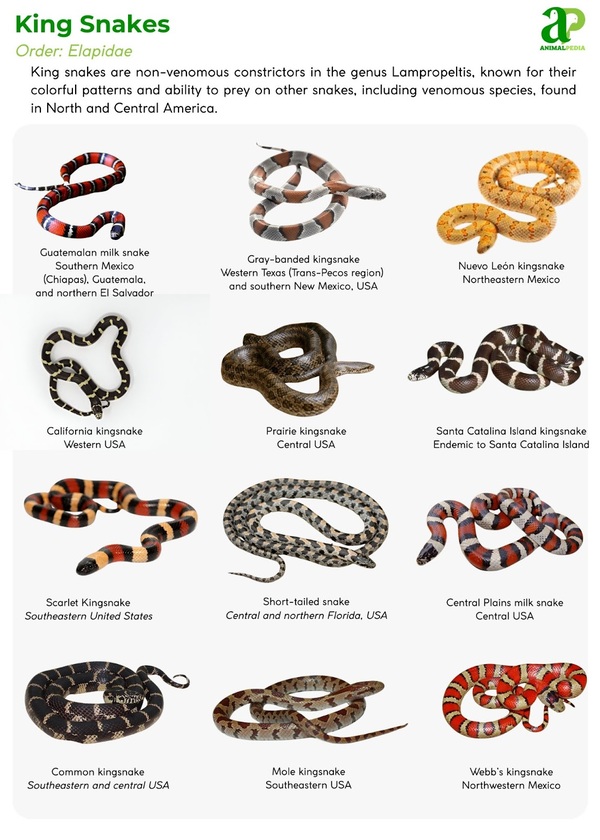
Special cases include hybrids, such as L. getula × L. triangulum crosses, which blur species lines in overlapping ranges. Subspecies, such as L. getula californiae, further diversify classification by adapting to unique habitats, such as deserts.
To better understand the organization of this reptilian group, dive deeper into the squamata classification and how it categorizes different species
Where Do King Snakes Live?
King snakes thrive across North and Central America, ranging from southern Canada to northern South America. They concentrate in the United States (California, Arizona, Texas), Mexico (Sonora, Baja California), and offshore islands like Isla Cerralvo. These regions provide the varied ecosystems—forests, grasslands, and deserts—that these adaptable reptiles require.
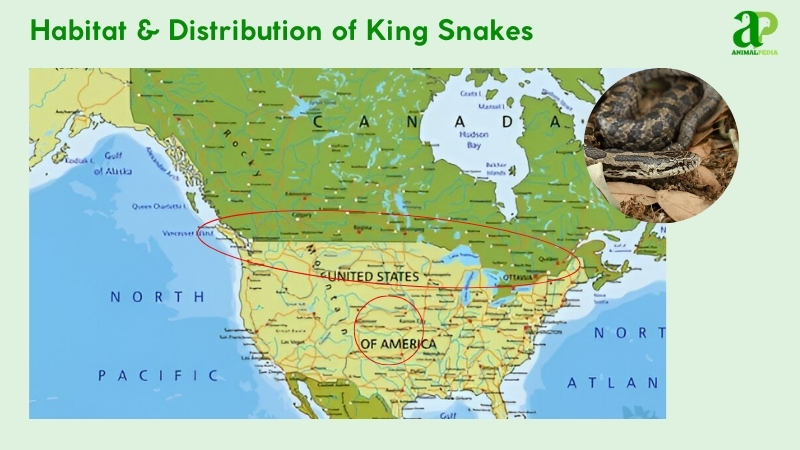
Their habitats feature warm climates, abundant prey (rodents, smaller reptiles), and natural cover such as rocks or logs—perfect for hunting and shelter. Their smooth scales enable efficient burrowing in sandy or loamy soils. Research from 2017 indicates that king snakes have inhabited these territories for millions of years without significant migration, thanks to their highly adaptable feeding habits and physiology.
Genetic studies published in 2019 confirm their long-established presence, revealing localized subspecies such as Lampropeltis getula californiae evolved specifically to exploit regional ecological niches, ensuring their survival across diverse terrains and environmental conditions.
How Do Seasonal Changes Affect Their Behavior?
King snakes (Lampropeltis spp.) exhibit behavioral shifts across three seasons: spring (March-May), summer (June-August), and fall/winter (September-February). These changes, driven by climate and prey availability, optimize survival in North American habitats.
- Spring: Mating peaks; males actively seek females, increasing movement. Feeding resumes post-hibernation, targeting rodents and reptiles.
- Summer: Egg-laying occurs; females seek warm, moist sites. Hunting intensifies, with snakes active day and night to exploit abundant prey.
- Fall/Winter: Brumation begins; snakes reduce activity and seek shelters such as burrows. Feeding slows and energy is conserved in cooler months.
What Is The Behavior Of King Snakes?
King snakes display adaptable behaviors as non-venomous constrictors throughout North America. Their survival patterns demonstrate flexibility, effectively balancing hunting strategies, movement patterns, and territorial behaviors according to environmental conditions.
- Feeding Habits: King snakes constrict prey, including rodents and reptiles. They consume other serpents, even venomous species, thanks to their natural immunity to venom.
- Bite Characteristics: Completely non-venomous, their bite poses no danger to humans. They subdue prey through powerful constriction rather than toxic injection.
- Activity Cycles: These reptiles are active during both daylight and nighttime hours, alternating between hunting and basking. Their movement intensity peaks during warmer seasons, with daily ranges of 0.5-1 mile (0.8-1.6 km).
- Movement Mechanics: Their smooth scales enable efficient slithering locomotion across diverse landscapes. Burrowing capabilities support both predation and concealment in habitats ranging from arid regions to woodland environments.
- Social Behavior: King snakes live solitary lives except during breeding seasons. They typically avoid group interactions, with minimal territorial disputes primarily driven by food resource availability.
- Communication Methods: They detect chemical signals through tongue-flicking behaviors for navigation. Various body postures communicate reproductive receptivity or defensive warnings.
Understanding their ecological function reveals how king snakes effectively regulate pest populations within their native habitats.
What Do King Snakes Eat?
Kingsnakes (Lampropeltis spp.) are strict carnivores with a famously robust diet. They prey on rodents, birds, amphibians, and even other reptiles—including venomous snakes. This powerful diet is a stark contrast to other common backyard snakes, like the Garter Snakes, which specializes in softer prey like earthworms and amphibians.
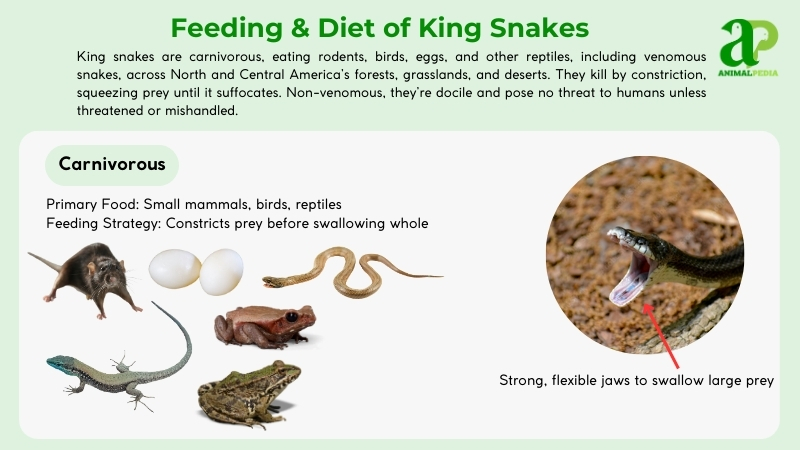
- Diet by Age
King snakes’ diets evolve with growth to meet energy demands.
-
- Hatchlings (0–6 months): Consume small lizards and mice, fueling rapid growth.
- Juveniles (6 months–2 years): Target medium rodents and small birds, honing hunting skills.
- Subadults (2–3 years): Pursue larger rodents and snakes, refining constriction.
- Adults (3+ years): Eat rodents, birds, and other snakes, thriving in forests and deserts
- Diet by Gender
Males and females share identical diets, focusing on rodents and reptiles. Both constrict and swallow prey whole, with females eating slightly more during egg-laying.
- Diet by Seasons
Seasons shape feeding patterns.
- Spring/Summer (March–August): Abundant prey, such as rodents, drives frequent hunting.
- Fall/Winter (September–February): Reduced prey availability slows feeding, and snakes brumate to conserve energy.
How Do King Snakes Hunt Their Prey?
King snakes hunt using a powerful constriction technique, demonstrating their adaptability. They kill by coiling around prey and cutting off blood flow. These snakes are opportunistic predators with a diverse diet. They actively hunt and consume other snakes, including venomous species such as rattlesnakes and copperheads, as well as non-venomous species such as gopher snakes, corn snakes, and bullsnakes.
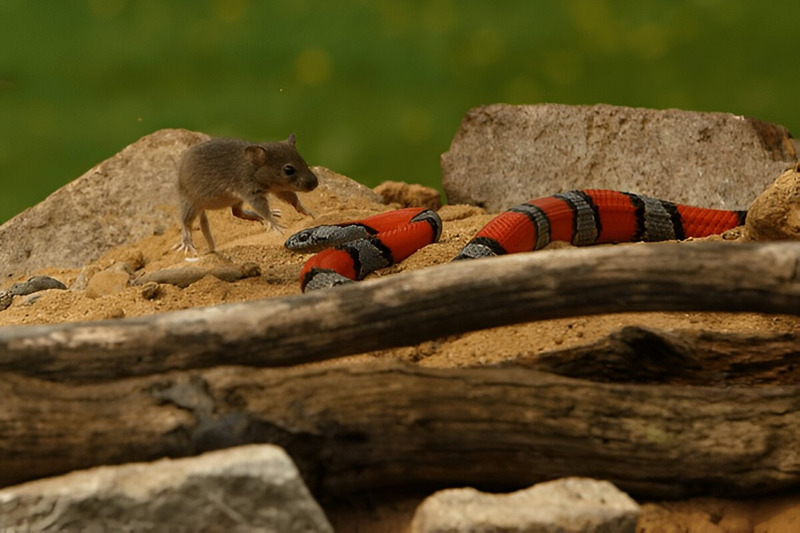
Their dietary flexibility extends beyond ophiophagy (snake-eating). King snakes regularly consume lizards, rodents, birds, and eggs—making them highly adaptable to various habitats. The California kingsnake subspecies exhibits exceptional constriction strength, generating pressure up to 180% of its body weight when subduing prey.
King snakes employ a specialized hunting strategy that combines stealth, speed, and power. They strike quickly, securing prey with their jaws before rapidly wrapping coils around the victim. Their immunity to pit viper venom gives them a significant advantage when hunting other snakes, allowing them to function as natural controllers of venomous snake populations in their ecosystems.
King Snakes don’t have venom. Instead, they rely on their physical strength and hunting skills to catch their prey. What’s even more impressive is their ability to consume venomous snakes without any adverse effects – a true superpower in the snake world!
Since King Snakes lack venom, they’ve developed unique survival tactics. Their keen sense of smell helps them find food, while their constricting ability allows them to overpower and eat a variety of animals, including much larger snakes.
Just picture being able to take down a venomous snake without any fear or harm! It’s no wonder these snakes are such skilled predators in their environment.
When Are King Snakes Most Active During The Day?
King Snakes are most active during the day, making them creatures that thrive in daylight hours. They’re lively and alert during this time, soaking up the sun’s warmth and actively hunting for prey. You can often see them moving around their habitats, exploring, and searching for food.
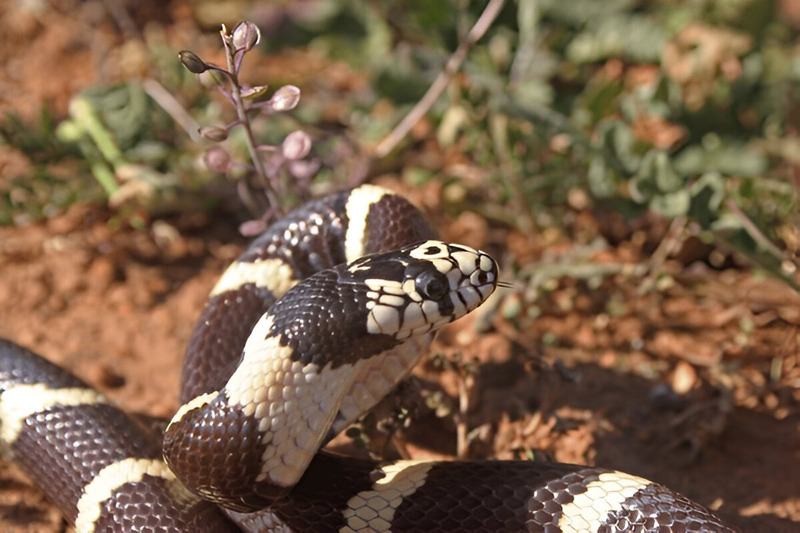
This daytime activity allows King Snakes to make effective use of the energy and opportunities provided by daylight hours. Their sharp senses and agility are crucial for their hunting success during these active periods.
Their climbing and swimming skills enable them to navigate their surroundings with ease, making them versatile hunters.
How Do King Snakes Move On Land And Water?
King Snakes employ distinct locomotion methods on land and in water. On land, they use lateral undulation—pushing against surface irregularities with their muscular bodies to propel forward.
These colubrid reptiles also utilize rectilinear movement when stalking prey, moving in a straight line by engaging their ventral scales. Concertina locomotion helps them navigate confined spaces by alternating between anchoring and extending their bodies.
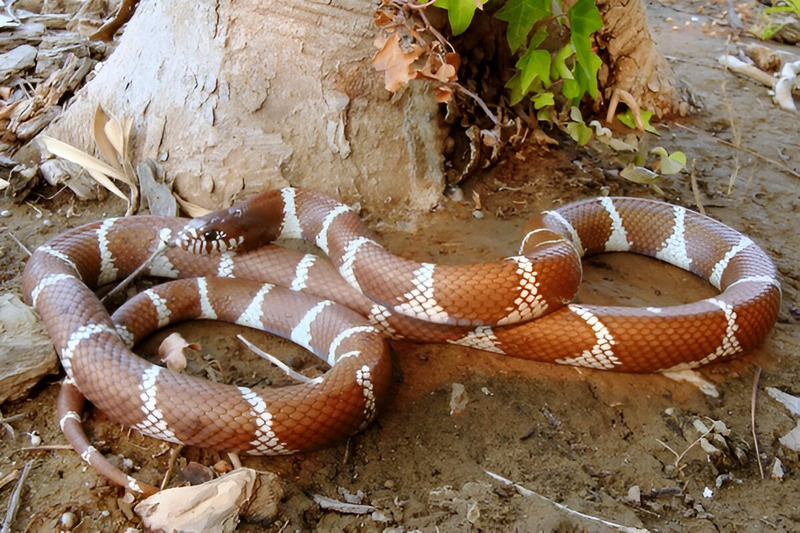
In aquatic environments, King Snakes demonstrate serpentine swimming patterns. They move through water using lateral body waves, creating an S-shaped motion that generates thrust against the water’s resistance. Their streamlined morphology enhances hydrodynamic efficiency, allowing them to maintain directional stability while swimming.
King Snakes exhibit biomechanical adaptability between terrestrial and aquatic habitats. Their ventral scales provide essential traction on land while their muscular torso enables efficient propulsion in water. This locomotor versatility is critical for their survival as mesopredators in diverse ecosystems.
The movement ecology of these snakes reflects evolutionary adaptations that balance energy efficiency with predatory needs and predator avoidance across varied terrain.
Do King Snakes Live Alone Or In Groups?
King Snakes are solitary creatures, preferring to live alone rather than in groups. This independent lifestyle allows them the freedom to roam their habitats without the need for companionship.
They’re self-sufficient hunters who use their exceptional skills to find and catch prey. By living solo, King Snakes can focus on their own survival, moving stealthily through their environments in search of food.
This solitary behavior also helps them avoid competition with other snakes for resources, giving them an advantage in the wild.
While the King Snake is a master hunter, other solitary snakes are masters of deception. The Eastern Hognose Snake is famous for its elaborate ‘playing dead’ act—a survival strategy that is pure theater
How Do King Snakes Communicate With Each Other?
King Snakes rely on subtle cues and signals to interact with others. One interesting method they use is releasing pheromones, chemicals that carry messages. These pheromones play a vital role in marking territories, attracting potential mates, and warning off rivals.
Apart from pheromones, King Snakes also communicate through body language. They might exhibit specific movements or postures to convey messages. For instance, when feeling threatened, a King Snake may coil its body tightly or flatten its head to appear larger and more threatening. Conversely, during courtship displays, they might perform elaborate dances to attract a mate.
How Do King Snakes Reproduce?
King snakes reproduce oviparously, laying eggs rather than giving birth to live young. Their breeding cycle begins in spring (March-May), when rising temperatures trigger reproductive behavior. Males track females by following pheromone trails, an efficient chemical communication system. Courtship involves tail vibrations and body alignment—a tactile ritual that may last hours. Receptive females signal their interest by coiling their bodies, leading to copulation, during which males use their hemipenes for internal fertilization.
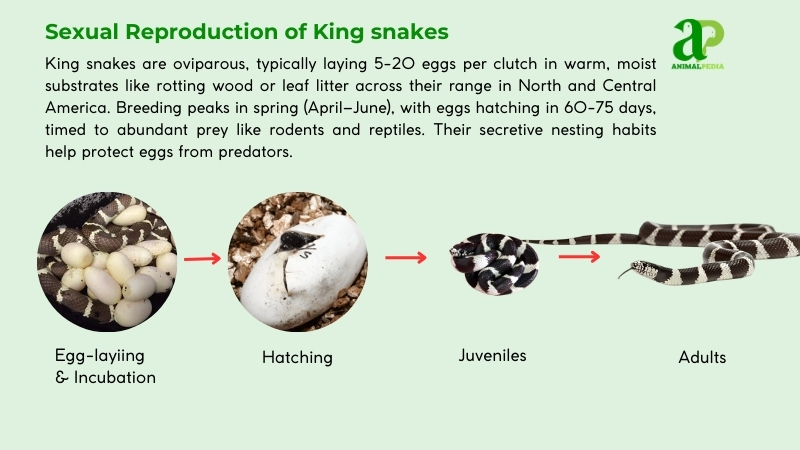
After mating, females deposit clutches of 3-24 eggs during the summer months (June-July). Each egg weighs 15-25 grams and contains all nutrients needed for embryonic development. Oviposition occurs in protected microhabitats—rotting logs, abandoned burrows, or leaf litter—that provide optimal incubation conditions. The female abandons her eggs immediately, offering no parental care. Environmental stressors like severe drought or nutritional deficiency can inhibit egg production, as documented in 2018 herpetological studies.
The incubation period lasts 50-60 days, after which 8-12 inch (20-30 cm) neonates emerge fully independent. These hatchlings immediately hunt small prey, such as lizards and juvenile rodents. They grow rapidly, reaching sexual maturity in 2-4 years. With lifespans of 15-20 years in wild habitats (longer in captivity), king snakes maintain stable populations across North America through this reproductive strategy that maximizes offspring numbers while minimizing parental investment.
How Long Do King Snakes Live?
King snakes (Lampropeltis spp.) live 15-20 years in their natural habitat, but can live up to 30 years in captivity with reliable nutrition and protection from predators. Their life development follows a clear pattern: emerging from eggs, reaching sexual maturity between 2 and 4 years, and reproducing yearly thereafter.
Both male and female kingsnakes generally enjoy similar longevity, though females might experience slightly shorter lives due to the physiological demands of egg production. Across their North American distribution, these constrictors from the colubrid family thrive longer with proper terrarium conditions and a consistent diet of rodents and other small prey.
What Are The Threats Or Predators That King Snakes Face Today?
King snakes face serious threats across North America today. Habitat destruction, road mortality, and climate change endanger their survival. Natural predators also hunt these powerful constrictors at different life stages.
- Habitat loss devastates king snake populations. Deforestation and urban development destroy essential shelters and eliminate prey sources. Recent studies show that 20% of habitats in the Southwestern United States have been degraded since 2019, limiting their range and reproductive success.
- Vehicle collisions kill thousands of king snakes yearly. These reptiles often cross roads while hunting or seeking mates, making them vulnerable to traffic. Research documents especially high mortality rates on rural highways, fragmenting populations, and isolating genetic groups.
- Climate shifts threaten king snake survival by disrupting their biological cycles. Altered temperatures affect brumation (reptile hibernation) and breeding patterns. Scientific models predict a 15% reduction in viable king snake territory by 2050.

Natural predators target these ophidians despite their defenses. Raptors like red-tailed hawks and great horned owls attack from above, while mammals such as foxes, coyotes, and raccoons raid nests for eggs. Larger snakes occasionally prey on king snakes, though their famous immunity to pit viper venom offers protection against rattlesnakes.
Human impact is most significant. Agricultural expansion and urban sprawl eliminate forests and grasslands where king snakes hunt. Pesticide use reduces rodent populations, indirectly starving these beneficial predators. The exotic pet trade removes wild specimens, depleting local populations. Ernst & Ernst’s research shows a 10-15% population decline in developed regions, highlighting the urgent need for conservation efforts to protect these valuable ecosystem regulators.
Are King Snakes Endangered?
King snakes are not endangered. They maintain robust populations throughout North and Central America, thriving in diverse ecosystems from forests to deserts.
The International Union for Conservation of Nature (IUCN) categorizes most king snake species as “Least Concern,” indicating minimal extinction risk. The Todos Santos Island king snake (Lampropeltis herrerae) lacks a formal IUCN assessment but faces localized threats. Their adaptability, varied prey selection, and successful reproduction patterns strengthen their survival prospects, according to 2019 herpetological research.
Population stability persists despite limited comprehensive data across its extensive range. Studies show Lampropeltis getula populations in the American Southwest are consistent with densities of 1-2 specimens per square kilometer in prime habitats. Ernst & Ernst’s 2017 reptile survey documented regular sightings throughout California and Arizona, suggesting that millions of reptiles exist across these regions. While urbanization causes some localized declines, king snakes continue to flourish due to their exceptional ecological versatility and resilience.
What Conservation Efforts Are Underway?
King snakes (Lampropeltis spp.) benefit from targeted conservation efforts addressing habitat loss and illegal trade. Since 2015, organizations such as Save The Snakes and the Phoenix Herpetological Society have protected habitats across North America, with a focus on California and Arizona. These initiatives restore forests and grasslands, ensuring prey availability and secure breeding sites.
Legal protections safeguard king snakes effectively. The Endangered Species Act (ESA) of 1973 regulates collection and commerce, prohibiting the unauthorized capture of vulnerable subspecies such as the Todos Santos Island king snake (Lampropeltis herrerae). California’s Fish and Game Code bans unlicensed collection, protecting species such as the San Diego mountain kingsnake (Lampropeltis zonata pulchra). These regulations help prevent overharvesting for the reptile trade, according to 2017 research.
Captive breeding programs bolster wild populations. The Phoenix Herpetological Society’s COBRA CARE program, active since 2018, breeds California kingsnakes (Lampropeltis californiae), achieving 80% hatchling survival rates. Zoological institutions, including the Sacramento Zoo, maintain genetic reservoirs of these colubrids, with 90% of bred milk snakes (Lampropeltis triangulum) reaching maturity, per 2019 data. These efforts stabilize populations and support reintroduction initiatives.
A conservation success story emerges from Baja California, where Save The Snakes restored 500 acres of habitat by 2020, increasing sightings of Lampropeltis herrerae by 15%. Community engagement reduced human-snake conflict, enhancing survival rates. These science-based programs ensure king snakes thrive despite urbanization and climate challenges, maintaining their ecological function as natural pest controllers.
Frequently Asked Questions
Do King Snakes Make Good Pets?
Yes, king snakes make great pets. They are low-maintenance, fascinating to observe, and come in a variety of colors and patterns. You’ll enjoy their docile nature and the fact that they are non-venomous.
How Do King Snakes Defend Themselves?
To defend themselves, king snakes use constriction to kill prey. They are opportunistic eaters and hunt other snakes, including venomous ones such as rattlesnakes. Their strong coils are adapted for this purpose.
Are King Snakes Endangered Species?
You don’t need to worry about king snakes being endangered. They are not threatened species. These adaptable reptiles thrive in a variety of habitats across North America. They are resilient and not facing extinction.
Can King Snakes Be Kept Together?
You can keep king snakes together, but guarantee adequate space, hiding spots, and similar-sized, non-aggressive individuals. Monitor for aggression or stress. Provide proper temperature and humidity levels. Consult a reptile expert to create a harmonious environment.
Conclusion
King snakes captivate observers with their bold color patterns, efficient hunting techniques, and resistance to venom. Throughout North America’s diverse ecosystems, these ophidians function as apex predators specializing in ophiophagy—the consumption of other serpents.
Their ecological significance extends beyond mere aesthetics, as they help control rodent populations and venomous snake numbers. The constrictors’ behavioral adaptations, including their perfect mimicry of coral snakes in some species and their specialized jaw structure, showcase evolutionary brilliance. For herpetologists and nature enthusiasts alike, king snakes represent a compelling subject for field observation and scientific study in their natural habitat.





